 Even with the resurgence of interest in Beaujolais, Juliénas, one of the region’s 10 crus, has been overlooked or under-rated. With Domaine Mont Bessay, Philippe Pascal and Guillaume Marko are changing that and, in the process, are redefining the wines from that cru.… Read more
Even with the resurgence of interest in Beaujolais, Juliénas, one of the region’s 10 crus, has been overlooked or under-rated. With Domaine Mont Bessay, Philippe Pascal and Guillaume Marko are changing that and, in the process, are redefining the wines from that cru.… Read more
Category Archives: France – Beaujolais
Château des Jacques, Moulin-à-Vent (Beaujolais, Burgundy, France) Clos des Thorins 2020 ($45, Kobrand)
 The venerable Beaune-based producer, Maison Louis Jadot, was ahead of its time when it purchased the famed Château des Jacques property in Moulin-à-Vent and set about defining the different terroirs—vineyard sites—in that appellation. Almost 30 years later, a bevy of Burgundy producers are doing the same thing.… Read more
The venerable Beaune-based producer, Maison Louis Jadot, was ahead of its time when it purchased the famed Château des Jacques property in Moulin-à-Vent and set about defining the different terroirs—vineyard sites—in that appellation. Almost 30 years later, a bevy of Burgundy producers are doing the same thing.… Read more
Château de La Chaize, Brouilly (Beaujolais, Burgundy, France) 2022 ($50, Vintus)
 I know, 95 points for a Beaujolais? Yes, this is one of, if not the best, Brouilly I have ever tasted. So, yes 95 points to get your attention. The La Chaize vineyard, a monopole, lies just behind the château on a very steep southeast facing slope.… Read more
I know, 95 points for a Beaujolais? Yes, this is one of, if not the best, Brouilly I have ever tasted. So, yes 95 points to get your attention. The La Chaize vineyard, a monopole, lies just behind the château on a very steep southeast facing slope.… Read more
Château de La Chaize, Fleurie (Beaujolais, Burgundy, France) La Chapelle des Bois 2022 ($43, Vintus)
 With this Fleurie, Château La Chaize shows that terroir is alive and well in Beuajolais. Their La Chapelle des Bois, a historically important lieu-dit in Fleurie, is wonderfully different from their Brouilly. It’s far more floral, firm, and minerally without the peppery accent that identifies their La Chaize vineyard in Brouilly.… Read more
With this Fleurie, Château La Chaize shows that terroir is alive and well in Beuajolais. Their La Chapelle des Bois, a historically important lieu-dit in Fleurie, is wonderfully different from their Brouilly. It’s far more floral, firm, and minerally without the peppery accent that identifies their La Chaize vineyard in Brouilly.… Read more
Domaine Mont Bessay, Juliénas (Beaujolais, France) En Bessay 2022
($60, Misa Imports):  The team of Philippe Pascal and Guillaume Marko have set the standard for Givry with their graceful wines from Domaine du Celliers aux Moines by focusing on specific parcels within the vineyard, matching the viticulture and the winemaking to the parcel, what the French call sélection parcellaire. … Read more
The team of Philippe Pascal and Guillaume Marko have set the standard for Givry with their graceful wines from Domaine du Celliers aux Moines by focusing on specific parcels within the vineyard, matching the viticulture and the winemaking to the parcel, what the French call sélection parcellaire. … Read more
Domaine Mont Bessay, Juliénas (Beaujolais, France) Quatre Cerisiers 2022
($60, Misa Imports):  Mont Bessay’s Quatre Cerisiers bottling comes from a small, 1.75-acre, plot some distance from the winery where the soil contains blue stone. Pascal and Marko marvel at how different Gamay behaves here compared to the parcels around the winery. … Read more
Mont Bessay’s Quatre Cerisiers bottling comes from a small, 1.75-acre, plot some distance from the winery where the soil contains blue stone. Pascal and Marko marvel at how different Gamay behaves here compared to the parcels around the winery. … Read more
Laura Lardy, Chénas (Beaujolais, France) “La Fayarde” 2022
($30):  Chénas, the smallest of the 10 Crus (named villages) of the Beaujolais region, is known for producing robust wines. Laura Lardy is one of Beaujolais’ top producers. Put the two together and you get this deeply rich wine with a balancing tarriness and uplifting freshness. … Read more
Chénas, the smallest of the 10 Crus (named villages) of the Beaujolais region, is known for producing robust wines. Laura Lardy is one of Beaujolais’ top producers. Put the two together and you get this deeply rich wine with a balancing tarriness and uplifting freshness. … Read more
Beaujolais Nouveau Day: May it Rest in Peace
The 2019 Cru Beaujolais Releases
The world loves Beaujolais. And for good reason. The various red wines of the Beaujolais region provide something for everyone, from simple “everyday” pizza wine to far more serious and structured ones from the crus, the top ten named villages. Sometimes the wines from the crus do not even carry the word Beaujolais on the label. … Read more
Georges DuBoeuf, Moulin-à-Vent (Beaujolais, France) “Domaine des Rosiers” 2019
($27, Quintessential Wines):  Wines from Moulin-à-Vent tend to be the sturdiest of all Beaujolais crus because of the granitic soil in that area. And there’s no doubt that you can taste and feel its presence in this wine. This Moulin-à-Vent, the most mineral-y of this trio of DuBoeuf Beaujolais crus, finishes with a balancing and welcome hint of bitterness. … Read more
Wines from Moulin-à-Vent tend to be the sturdiest of all Beaujolais crus because of the granitic soil in that area. And there’s no doubt that you can taste and feel its presence in this wine. This Moulin-à-Vent, the most mineral-y of this trio of DuBoeuf Beaujolais crus, finishes with a balancing and welcome hint of bitterness. … Read more
Georges DuBoeuf, Morgon (Beaujolais, France) Côte du Py “Jean-Ernest Descombes” 2019
($35, Quintessential Wines):  The Côte du Py, a blue-stone slope, is the best-known subregion within the Morgon appellation. Gamay grown here takes on a firm and distinct mineral-like character, which often takes a couple of years to soften. However, the warmth of the 2019 vintage brought out a ripe bright dark cherry-like fruit in this Côte du Py. … Read more
The Côte du Py, a blue-stone slope, is the best-known subregion within the Morgon appellation. Gamay grown here takes on a firm and distinct mineral-like character, which often takes a couple of years to soften. However, the warmth of the 2019 vintage brought out a ripe bright dark cherry-like fruit in this Côte du Py. … Read more
Georges DuBoeuf, Juliénas (Beaujolais, France) “Château des Capitans” 2019
($23, Quintessential Wines):  Juliénas is one of the 10 crus, or named villages, of Beaujolais that labels the wine with the village name, omitting Beaujolais entirely. In addition to his “flower label” bottlings of Beaujolais, DuBoeuf produces or commercializes a bevy of notable ones, such as this one. … Read more
Juliénas is one of the 10 crus, or named villages, of Beaujolais that labels the wine with the village name, omitting Beaujolais entirely. In addition to his “flower label” bottlings of Beaujolais, DuBoeuf produces or commercializes a bevy of notable ones, such as this one. … Read more
Château des Jacques, Moulin-à-Vent (Beaujolais, France) 2017
($26, Kobrand Wine & Spirits):  Beaujolais is still trying to remind people it produces real, top-notch wine, not just “nouveau.” Well, Jadot’s Château des Jacques is a convincing exhibit. For over 20 years, Château des Jacques has been instrumental in showing the diversity of wines from within the crus of Beaujolais, those ten named villages, such as Moulin-à-Vent, whose wines are so distinctive that they may not even carry the name Beaujolais on the label. … Read more
Beaujolais is still trying to remind people it produces real, top-notch wine, not just “nouveau.” Well, Jadot’s Château des Jacques is a convincing exhibit. For over 20 years, Château des Jacques has been instrumental in showing the diversity of wines from within the crus of Beaujolais, those ten named villages, such as Moulin-à-Vent, whose wines are so distinctive that they may not even carry the name Beaujolais on the label. … Read more
Château de La Chaize, Brouilly (Beaujolais, Burgundy, France) 2017
($19, Taub Family Selections):  Brouilly, the largest of the ten Beaujolais cru, often disappoints. Thankfully, the 2017 from Château de La Chaize, one of the top producers of Brouilly, does not. It has good concentration, zippy acidity that keeps it fresh and lively, and lots of juicy fruitiness. … Read more
Brouilly, the largest of the ten Beaujolais cru, often disappoints. Thankfully, the 2017 from Château de La Chaize, one of the top producers of Brouilly, does not. It has good concentration, zippy acidity that keeps it fresh and lively, and lots of juicy fruitiness. … Read more
Domaine de Rochegrès (Bichot), Domaine de Rochegrès (Bichot) (Beaujolais, Burgundy, France) 2018
($28):  Bichot purchased this 12.5-acre estate in the heart of Moulin-a-Vent, arguably the top Beaujolais cru, in 2014. The grapes come from three lieux-dits within Moulin-a-Vent, La Rochelle, Au Mont, and the young vines from Rochegrès itself. It is ripe, spicy and suave, combining richness, minerality and bright acidity. … Read more
Bichot purchased this 12.5-acre estate in the heart of Moulin-a-Vent, arguably the top Beaujolais cru, in 2014. The grapes come from three lieux-dits within Moulin-a-Vent, La Rochelle, Au Mont, and the young vines from Rochegrès itself. It is ripe, spicy and suave, combining richness, minerality and bright acidity. … Read more
P. Ferraud et Fils, Saint-Amour (Beaujolais, France) 2017
($17):  Saint-Amour is the most northern Beaujolais cru and the second smallest, after Chénas. Clay in the granitic soil here adds an oomph to the wines, according to growers to whom I spoke. Ferraud’s is wonderfully fragrant and immediately enticing. After its floral allure, its power comes as a surprise, but a welcome one because it is not overdone. … Read more
Saint-Amour is the most northern Beaujolais cru and the second smallest, after Chénas. Clay in the granitic soil here adds an oomph to the wines, according to growers to whom I spoke. Ferraud’s is wonderfully fragrant and immediately enticing. After its floral allure, its power comes as a surprise, but a welcome one because it is not overdone. … Read more
P. Ferraud et Fils, Moulin-à-Vent (Beaujolais, France) “La Dynastie des Ferraud” 2015
($30):  Though Ferraud’s wines have been in the U.S. market in the past, they currently have no importer, which is a shame because they consistently make distinctive Beaujolais. (The prices I quote come from a world-wide averages.) My experience with their wines comes from decades ago when they were imported and, more recently, drinking them in Paris bistros. … Read more
Though Ferraud’s wines have been in the U.S. market in the past, they currently have no importer, which is a shame because they consistently make distinctive Beaujolais. (The prices I quote come from a world-wide averages.) My experience with their wines comes from decades ago when they were imported and, more recently, drinking them in Paris bistros. … Read more
P. Ferraud & Fils, Moulin-à-Vent (Beaujolais, France) “L’Éolienne” 2016
($25):  Ferraud has had presence on the U.S. market for decades, but currently lacks an importer. That’s a shame because their wines are distinctive and unique. Take this one — a classic Moulin-à-Vent with fruit-infused charm, minerality, and a lovely fleshiness. … Read more
Ferraud has had presence on the U.S. market for decades, but currently lacks an importer. That’s a shame because their wines are distinctive and unique. Take this one — a classic Moulin-à-Vent with fruit-infused charm, minerality, and a lovely fleshiness. … Read more
Domaine Ruet, Morgon (Beaujolais, France) Douby 2017
($25, Schatzi Wines):  Consumers can select anything that Domaine Ruet makes and be happy with it. This Morgon, from the climat (or vineyard) Douby, is sensational. It has the firmness for which Morgon is known, but with a charming fruitiness and haunting minerality. … Read more
Consumers can select anything that Domaine Ruet makes and be happy with it. This Morgon, from the climat (or vineyard) Douby, is sensational. It has the firmness for which Morgon is known, but with a charming fruitiness and haunting minerality. … Read more
Louis Tête, Beaujolais-Villages (France) 2017
($14):  Beaujolais-Villages is a wine that comes from any one or a combination of 38 specified villages, and the category is thought to have the potential for more interesting wines compared to those labeled Beaujolais. This one is juicy, with good weight and concentration, yet not heavy or overly fruity. … Read more
Beaujolais-Villages is a wine that comes from any one or a combination of 38 specified villages, and the category is thought to have the potential for more interesting wines compared to those labeled Beaujolais. This one is juicy, with good weight and concentration, yet not heavy or overly fruity. … Read more
Beaujolais: A Versatile Wine
One of the many things I love about Beaujolais is its variety and versatility. There’s Beaujolais Nouveau, a beverage that’s almost closer to alcoholic grape juice than to wine, and which many in the American wine press deride regularly. Released on the third Thursday of November, it can be a refreshing, all-purpose wine for the Thanksgiving table. … Read more
Domaine Bel Avenir, Moulin-à-Vent (Beaujolais, France) En Mortperay 2017
($25):  Growers in Moulin-à-Vent, the most robust of the 10 crus of Beaujolais, have embraced the concept of making wines from specific sites, just as in the Côte d’Or, their more famous neighbor in Burgundy to the north. En Mortperay is one such site, situated on the edge of the appellation, bordering Fleurie. … Read more
Growers in Moulin-à-Vent, the most robust of the 10 crus of Beaujolais, have embraced the concept of making wines from specific sites, just as in the Côte d’Or, their more famous neighbor in Burgundy to the north. En Mortperay is one such site, situated on the edge of the appellation, bordering Fleurie. … Read more
Dominique Piron, Morgon (Beaujolais, France) Côte du Py 2017
($30):  The Côte du Py is arguably the most famous climat or vineyard in Morgon and possibly all of Beaujolais. Composed of back stone, it can be home to power and dense wines that need considerable age before revealing their charms. … Read more
The Côte du Py is arguably the most famous climat or vineyard in Morgon and possibly all of Beaujolais. Composed of back stone, it can be home to power and dense wines that need considerable age before revealing their charms. … Read more
P. Ferraud & Fils, Morgon (Beaujolais, France) Les Charmes 2018
($20):  Ferraud, though lacking a U.S. importer now, had been in this market for decades and is a well-established name with a proven track record. Yves-Dominique Ferraud told me he thought the 2018 vintage in Beaujolais was a combination of the ripeness of 2015 and the raciness of 2016.… Read more
Ferraud, though lacking a U.S. importer now, had been in this market for decades and is a well-established name with a proven track record. Yves-Dominique Ferraud told me he thought the 2018 vintage in Beaujolais was a combination of the ripeness of 2015 and the raciness of 2016.… Read more
Domaine Ruet, Côte de Brouilly (Beaujolais, France) 2017
($23, Schatzi Wines):  I recently tasted six Beaujolais from this producer, one made without added sulfur, from three different vintages, 2016, 2017 and 2018. They were stunning across the board and demonstrated the enormous talent at the domaine. They have just under 3 acres on the slopes of Côte de Brouilly, one of the 10 crus of Beaujolais. … Read more
I recently tasted six Beaujolais from this producer, one made without added sulfur, from three different vintages, 2016, 2017 and 2018. They were stunning across the board and demonstrated the enormous talent at the domaine. They have just under 3 acres on the slopes of Côte de Brouilly, one of the 10 crus of Beaujolais. … Read more
Piron & Lameloise, Chénas (Beaujolais, France) “Quartz” 2016
($23):  The Lameloise family, whose name is synonymous with fine dining because of their Michelin 3-star restaurant in nearby Chagny, owns the vineyard in Chénas, the smallest of the 10 crus of Beaujolais, while Dominique Piron makes the wines. Floral and elegant, it’s a graceful wine that dances on the palate. … Read more
The Lameloise family, whose name is synonymous with fine dining because of their Michelin 3-star restaurant in nearby Chagny, owns the vineyard in Chénas, the smallest of the 10 crus of Beaujolais, while Dominique Piron makes the wines. Floral and elegant, it’s a graceful wine that dances on the palate. … Read more
Louis Tête, Côte de Brouilly (Beaujolais, France) Chante-Loup 2018
($15):  Côte de Brouilly, one of the 10 crus, or named villages of Beaujolais, is really a small mountain that emerges from Brouilly, another of the named villages. It has many lieux-dits (place names) on its slope. More and more, Beaujolais producers are identifying specific sites within the cru because they believe the wines are distinctive and reflect the site, just as in the rest of Burgundy. … Read more
Côte de Brouilly, one of the 10 crus, or named villages of Beaujolais, is really a small mountain that emerges from Brouilly, another of the named villages. It has many lieux-dits (place names) on its slope. More and more, Beaujolais producers are identifying specific sites within the cru because they believe the wines are distinctive and reflect the site, just as in the rest of Burgundy. … Read more
Domaine Mee Godard, Morgon (Beaujolais, Burgundy, France) Grand Cras 2017
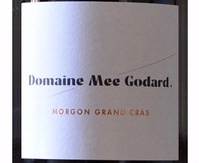
($32): Realizing the diversity of soils within Morgon, the wine producers there divided that appellation into six fairly large (averaging about 450 acres) climats, one of which is Grand Cras. This one, from Mee Godard, one of the rising stars in Morgon, comes from a single 1-acre plot of 20-year-old vines. … Read more
Domaine Mee Godard, Moulin-à-Vent (Beaujolais, Burgundy, France) Michelons 2017

($27): Godard just acquired a vineyard in Moulin-à-Vent, expanding her holdings to about 16 acres in total. Au Michelon, located in the northern part of Moulin-à-Vent, has dark stones and dark sandy soil, according to Godard, which she says gives the wine a combination of power and elegance. … Read more
Domaine Mee Godard, Morgon (Beaujolais, Burgundy, France) Corcelette 2017

($29): Mee Godard, a young woman originally from Korea, is one of the rising shining stars of Beaujolais. Her wines are not to be missed because of their precision and distinctiveness, not to mention their sheer deliciousness. Located in Morgan, she bottled three different wines in 2017 from various climats (vineyards) in that cru, Corcelette, Côte de Py and Grand Cras. … Read more
Domaine Mee Godard, Morgon (Beaujolais, Burgundy, France) Côte de Py 2017
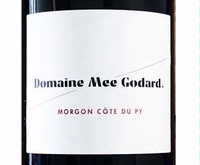
($37): The union of Morgon producers divided Morgon into six climats according to soil type about 50 years ago, according to Godard. Now, more and more producers there — and in Moulin-à-Vent as well — are putting these sites on labels. … Read more
Château Thivin, Côte de Brouilly (Beaujolais, Burgundy, France) 2017
($28, Kermit Lynch): 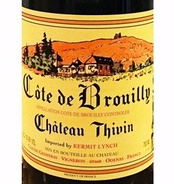 Château Thivin is THE producer Côte de Brouilly, one of the ten crus of Beaujolais, which sits on a small ancient volcanic cone. The Geoffray family purchased the estate, which had been in existence since the 12th century, in 1877. … Read more
Château Thivin is THE producer Côte de Brouilly, one of the ten crus of Beaujolais, which sits on a small ancient volcanic cone. The Geoffray family purchased the estate, which had been in existence since the 12th century, in 1877. … Read more
Château Thivin, Brouilly (Beaujolais, Burgundy, France) “Reverdon” 2017
($24, Kermit Lynch): 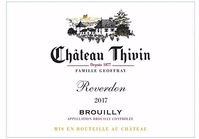 Château Thivin owns about 18 acres of this 65-acre east-facing vineyard in Brouilly, the largest and most southern of Beaujolais’ ten cru. Lighter and fruitier than their Côte de Brouilly, it still conveys underlying minerality because of the rose-granite soil in the vineyard. … Read more
Château Thivin owns about 18 acres of this 65-acre east-facing vineyard in Brouilly, the largest and most southern of Beaujolais’ ten cru. Lighter and fruitier than their Côte de Brouilly, it still conveys underlying minerality because of the rose-granite soil in the vineyard. … Read more
Pierre-Marie Chermette, Fleurie (Beaujolais, Burgundy, France) Les Garants 2016
($26, Weygandt-Metzler): 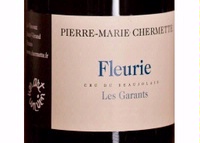 Pierre-Marie Chermette’s Fleurie Garants, though on the same pink granite soil as their Fleurie Poncié, comes from a southwest facing slope, which exposes it to warmer afternoon sun. Still highlighting the mineral component, it’s a slightly firmer, more muscular wine that maintains the incredible suaveness, which is always present in Chermette’s wines.… Read more
Pierre-Marie Chermette’s Fleurie Garants, though on the same pink granite soil as their Fleurie Poncié, comes from a southwest facing slope, which exposes it to warmer afternoon sun. Still highlighting the mineral component, it’s a slightly firmer, more muscular wine that maintains the incredible suaveness, which is always present in Chermette’s wines.… Read more
Pierre-Marie Chermette, Fleurie (Beaujolais, Burgundy, France) Poncié 2016
($26, Weygandt-Metzler): 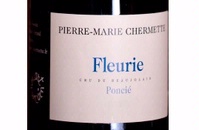 Pierre-Marie Chermette, a well-regarded producer in Fleurie, one of the cru of Beaujolais, focuses on terroir — site specificity — in keeping with the tradition in the rest of Burgundy. Chermette produces two excellent, but very different Fleurie, this one from Poncié and one from a slope called Garants.… Read more
Pierre-Marie Chermette, a well-regarded producer in Fleurie, one of the cru of Beaujolais, focuses on terroir — site specificity — in keeping with the tradition in the rest of Burgundy. Chermette produces two excellent, but very different Fleurie, this one from Poncié and one from a slope called Garants.… Read more
Domaine Labruyère, Moulin-à-Vent (Beaujolais, Burgundy, France) “Coeur de Terroirs” 2016
($27, Frederick Wildman and Sons): 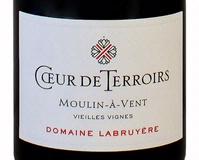 Domaine Labruyère, a serious producer based in Moulin-à-Vent, has a variety of bottlings from that Beaujolais cru. This one, a blend of grapes from older vines and aged in older oak barrels, reminds us of just how good and exciting wines from Moulin-à-Vent can be. … Read more
Domaine Labruyère, a serious producer based in Moulin-à-Vent, has a variety of bottlings from that Beaujolais cru. This one, a blend of grapes from older vines and aged in older oak barrels, reminds us of just how good and exciting wines from Moulin-à-Vent can be. … Read more
Domaine Labruyère, Moulin-à-Vent (Beaujolais, Burgundy, France) “Le Clos” 2016
($36, Frederick Wildman and Sons): 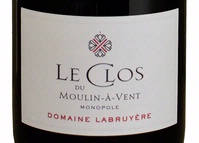 I hear it already, “How can you give Beaujolais 95 points?” First, this is not Beaujolais really; it’s from Moulin-à-Vent, arguable the best of the 10 cru of Beaujolais, which taken together, are in a class by themselves. … Read more
I hear it already, “How can you give Beaujolais 95 points?” First, this is not Beaujolais really; it’s from Moulin-à-Vent, arguable the best of the 10 cru of Beaujolais, which taken together, are in a class by themselves. … Read more
Château Thivin, Côte de Brouilly (Beaujolais, Burgundy, France) 2015
($28): 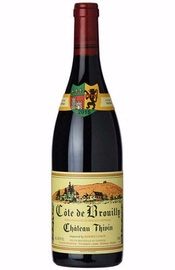 The wines from Côte de Brouilly, one of top-tier of the ten cru of Beaujolais, are not to be confused with those from Brouilly, another cru, but whose wines have less consistent quality. Although Château Thivin, one of the region’s best producers, makes a range of wines from Côte de Brouilly depending on the position of the vines on the slope, this one is a blend from several sites. … Read more
The wines from Côte de Brouilly, one of top-tier of the ten cru of Beaujolais, are not to be confused with those from Brouilly, another cru, but whose wines have less consistent quality. Although Château Thivin, one of the region’s best producers, makes a range of wines from Côte de Brouilly depending on the position of the vines on the slope, this one is a blend from several sites. … Read more
Château de Fleurie, Fleurie (Beaujolais, Burgundy, France) 2015
($21, David Bowler Wine): 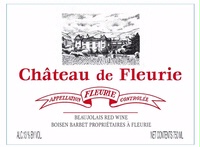 Sensational is the word that comes to mind when describing the 2015 vintage in Beaujolais. Of course, we are talking about the cru of Beaujolais, the ten villages within that region whose wines stand apart from the remainder of the region, which explains why the name of the cru alone — without the word Beaujolais — appears on the label. … Read more
Sensational is the word that comes to mind when describing the 2015 vintage in Beaujolais. Of course, we are talking about the cru of Beaujolais, the ten villages within that region whose wines stand apart from the remainder of the region, which explains why the name of the cru alone — without the word Beaujolais — appears on the label. … Read more
Georges Duboeuf, Fleurie (Beaujolais, Burgundy, France) Domaine des Quatre Vents 2015
($18, Quintessential): 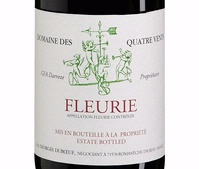 The reputation of Beaujolais is that of an easy-drinking fruity wine to be consumed soon after release. That description may be accurate for most Beaujolais, but not those from ten villages, known as the cru of Beaujolais, whose wines are far more distinctive. … Read more
The reputation of Beaujolais is that of an easy-drinking fruity wine to be consumed soon after release. That description may be accurate for most Beaujolais, but not those from ten villages, known as the cru of Beaujolais, whose wines are far more distinctive. … Read more
Château du Basty, Régnié (Beaujolais, Burgundy, France) 2015
($16, Jeanne Marie de Champs Selection): 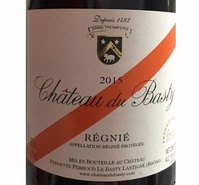 The wines from Régnié, the last of the 10 villages in Beaujolais to achieve cru status, have a tendency to be hard and rustic. Not this one. This Régnié from the Château du Basty shows great refinement. … Read more
The wines from Régnié, the last of the 10 villages in Beaujolais to achieve cru status, have a tendency to be hard and rustic. Not this one. This Régnié from the Château du Basty shows great refinement. … Read more
The New Beaujolais, but Definitely Not Beaujolais Nouveau
A recent tasting of Beaujolais reminded me of tasting wines from the Côte d’Or. Yes, you read that correctly–I am comparing Beaujolais and the Côte d’Or. To be sure, I’m not speaking about just anywhere in Beaujolais, only the crus, the 10 villages in the northern part of the region whose bedrock is either pink granite or a blue-black volcanic stone and whose wines are so distinctive that only the name of the village, without a mention of Beaujolais, appears on the label.… Read more
Domaine J. Chamonard, Morgon (Beaujolais, France) “Le Clos de Lys” 2014
($32, Savio Soares Selections):  It’s hard to determine from the importer’s website whether Le Clos de Lys is actually a single vineyard or a proprietary name for a wine that comes from several parcels in Morgon. No matter, the wine is excellent and reinforces my opinion that the cru of Beaujolais will be the next hot area for French wine. … Read more
It’s hard to determine from the importer’s website whether Le Clos de Lys is actually a single vineyard or a proprietary name for a wine that comes from several parcels in Morgon. No matter, the wine is excellent and reinforces my opinion that the cru of Beaujolais will be the next hot area for French wine. … Read more
Frédéric Berne, Morgon (Beaujolais, France) Corcelette 2014
($20):  I only became acquainted with Frédéric Berne’s Beaujolais during my annual trip to Burgundy last November. Based on my tasting of his 2014s, I would try anything he makes. He, like many of the top producers in Beaujolais, is raising the bar in that region by identifying vineyards within the cru (the 10 towns that produce the most distinctive wines) that have unique terroir and are capable of making superior wines. … Read more
I only became acquainted with Frédéric Berne’s Beaujolais during my annual trip to Burgundy last November. Based on my tasting of his 2014s, I would try anything he makes. He, like many of the top producers in Beaujolais, is raising the bar in that region by identifying vineyards within the cru (the 10 towns that produce the most distinctive wines) that have unique terroir and are capable of making superior wines. … Read more
Maison Joseph Drouhin, Fleurie (Beaujolais, France) Domaine des Hospices de Belleville 2015
($25, Dreyfus, Ashby & Co.):  Beaujolais is clearly a hot area. Major Beaune-based Burgundy négociants are investing there, either by buying properties, such as Jadot with Château des Jacques, or, as with Drouhin, collaborating with the Domaine des Hospices de Belleville to produce and market their wines. … Read more
Beaujolais is clearly a hot area. Major Beaune-based Burgundy négociants are investing there, either by buying properties, such as Jadot with Château des Jacques, or, as with Drouhin, collaborating with the Domaine des Hospices de Belleville to produce and market their wines. … Read more
Frédéric Berne, Chiroubles (Beaujolais, France) Les Terrasses 2015
($20):  Wines from Chiroubles, another one of the ten cru of Beaujolais, are typically fruitier and less firm than those from Morgon. Berne’s 2015 Chiroubles from Les Terrasses, one of the top spots in that village, is exuberant without being over the top. … Read more
Wines from Chiroubles, another one of the ten cru of Beaujolais, are typically fruitier and less firm than those from Morgon. Berne’s 2015 Chiroubles from Les Terrasses, one of the top spots in that village, is exuberant without being over the top. … Read more
A Game-Changing Development in Beaujolais
Everyone knows THE grape in Beaujolais is Gamay. Ok, a little Chardonnay, which finds its way into Beaujolais Blanc or even Bourgogne Blanc, is planted in the region as well. But now, a game-changer could transform and revitalize the region–a major Burgundian producer has started planting and making wine from Pinot Noir in Beaujolais. … Read more
Beauty in Beaujolais: the 2015 Vintage
When I was in Côte d’Or and Beaujolais last November, all the producers with whom I spoke were absolutely raving about the 2015 vintage. The exuberance in Beaujolais–perhaps because the wines were closer to being finished than in the Côte d’Or–was even more palpable and universal. … Read more
Beaujolais Rising
A transformation is occurring in Beaujolais, and within a few years the world will see the wines from that region in a whole new light. For most consumers today, Beaujolais is synonymous with Beaujolais Nouveau, which all too often is a grapey, gooey wine.… Read more
Château du Moulin-à-Vent, Moulin-à-Vent (Beaujolais, Burgundy, France) 2012
($30, Wilson Daniels):  Moulin-à-Vent, with its iconic windmill perched at the top of the hill, is the most revered of the ten crus of Beaujolais. The cru are small areas in the north of Beaujolais with granitic soil which produce wines that couldn’t be further from the tutti-frutti character of Beaujolais Nouveau, which, sadly, remains the image of the region to far too many consumers. … Read more
Moulin-à-Vent, with its iconic windmill perched at the top of the hill, is the most revered of the ten crus of Beaujolais. The cru are small areas in the north of Beaujolais with granitic soil which produce wines that couldn’t be further from the tutti-frutti character of Beaujolais Nouveau, which, sadly, remains the image of the region to far too many consumers. … Read more
